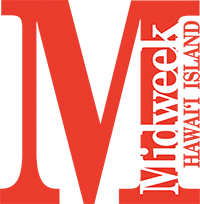Sealing The Deal
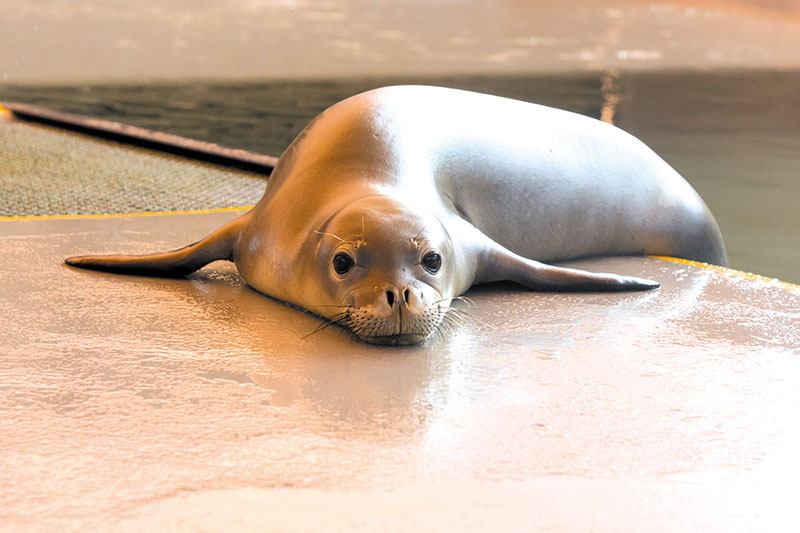
Hawaiian monk seal pup Lele-aka arrived at The Marine Mammal Center’s Ke Kai Ola hospital with three others back in 2016. JULIE STEELMAN PHOTO, THE MARINE MAMMAL CENTER, NOAA PERMIT #18786
The work being done at The Marine Mammal Center’s Ke Kai Ola facility has helped save hundreds of Hawaiian monk seals.
Fronting the ocean at Natural Energy Laboratory of Hawai‘i Authority, a small but mighty facility is helping make a big difference in the lives of critically endangered Hawaiian monk seals. Ke Kai Ola (“the healing sea”), a program of The Marine Mammal Center, is a Hawaiian monk seal hospital in Kailua-Kona that employs three full-time and two part-time animal husbandry and education staff members, as well as about 100 response volunteers and 50 on-site animal care volunteers.
The only tropical pinnipeds remaining in the world, Hawaiian monk seals now number about 300-400 in the main Hawaiian Islands, and about 1,400 total.
“We are the only long-term care hospital especially for Hawaiian monk seals anywhere in the world,” says animal programs manager Megan McGinnis.
She explains that the center, supported and sponsored by National Oceanic and Atmospheric Administration, cares for sick, injured and orphaned seals, most of whom are brought in from Laysan Island, which is part of the Papahānaumokuākea Marine National Monument. In the summer, volunteer research campers are dropped off with supplies on Laysan by NOAA research vessels and spend three to four months there monitoring seals, especially the newborns. In the fall, the vessel returns to retrieve the campers, as well as any seals they’ve been observing who are in trouble. The animals are brought to Hawai‘i and admitted to the center for long-term care and rehabilitation.
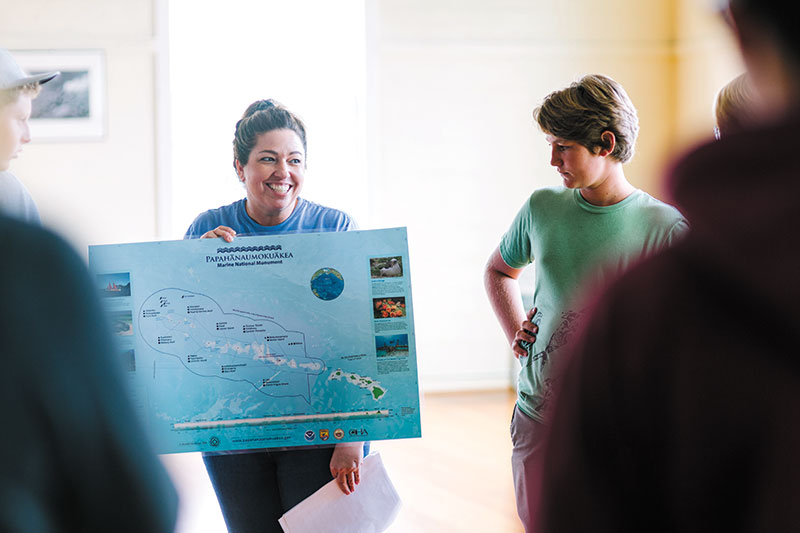
Wendy Marks teaches students about Papahanaumokuakea Marine National Monument. ELENA GRAHAM PHOTO, THE MARINE MAMMAL CENTER
“Most of the seals are juveniles in pre-weaned condition, meaning they are dehydrated, emaciated and have chronic nutritional concerns,” says McGinnis. “Hawaiian monk seals weigh about 35 pounds at birth, and often their moms bail before the six-week weaning period is over. When mom leaves early, they have a very low survival rate.”
She says the center also treats them for debilitating parasites such as tapeworms and roundworms. In addition, center staff have recently begun to support an effort to vaccinate Hawaiian monk seals against the lethal morbillivirus, a type of distemper that has killed thousands of marine mammals on the Atlantic coast.
Reasons for the decline of the Hawaiian monk seal are many: loss of habitat due to sea level rise, predation by Galapagos sharks, skewed gender numbers (far more males than females, which can cause the female to be mobbed and drowned during mating), infectious diseases, fishing entanglements and competition for resources. In the main Hawaiian Islands, seals mostly face hazards related to human disturbance.
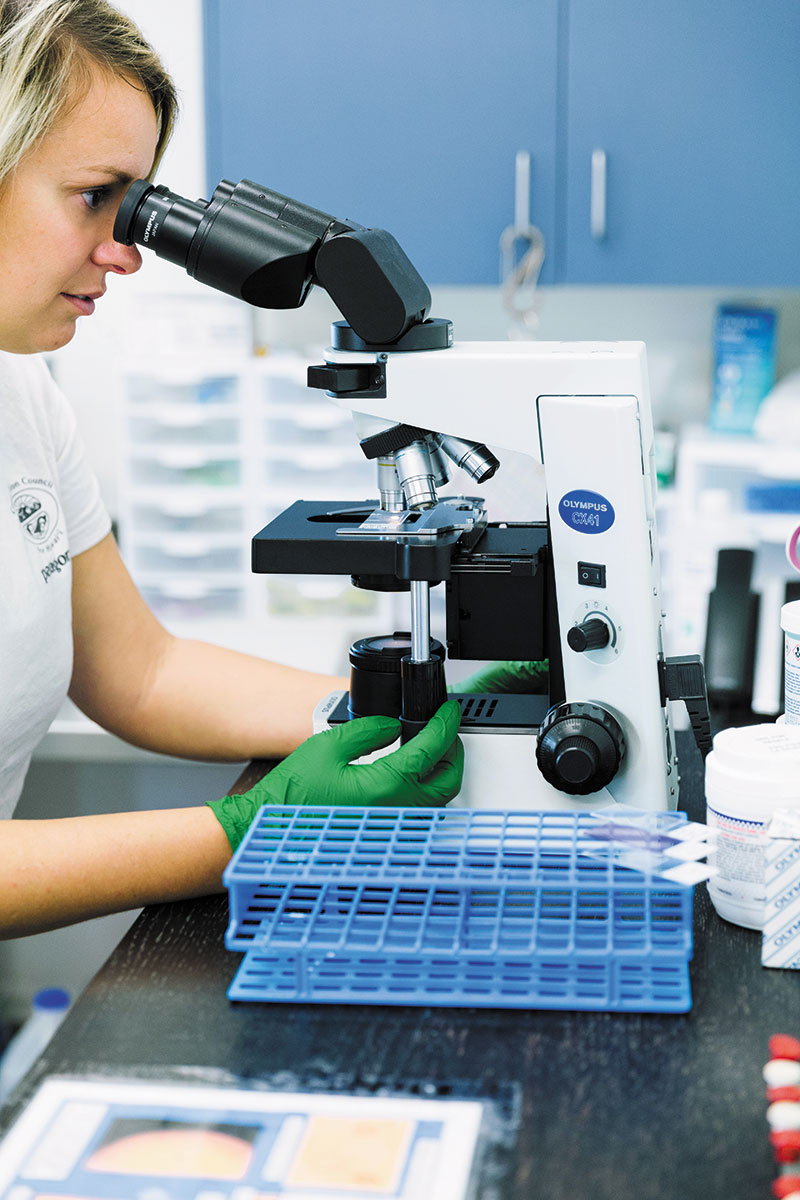
Animal programs manager Megan McGinnis examines blood samples under a microscope from rehabilitating Hawaiian monk seal patients. ELENA GRAHAM PHOTO, THE MARINE MAMMAL CENTER
At the center, four rehabilitation pools with dry haul-out areas serve between seven to 10 patients. Care-givers downplay interaction as much as possible so that the seals don’t develop human habituation and attachments. They don’t talk while inside the rehab area, hiding behind blue herding boards, and don’t allow the animals to make a connection with the people feeding them.
“We basically hide and throw the food over, so for all they know is that it came from the sky,” says McGinnis with a laugh.
This discourages the seals from forming bonds with people, which puts them at a disadvantage in the wild, as well creating a safety hazard for the public when seals are hauled out on populated beaches. They remain hospitalized at the center for about three to four months.
“We know it can be boring in the hospital,” McGinnis explains. “But we have to be very careful about what we give them to play with. They may look like toys, but every enrichment device has a purpose and is meant to mimic feeding patterns they might encounter in the wild.”
When it’s time to release the patients, the NOAA vessel arrives at Honokāhau Harbor. Staff and volunteers crate the seals and weigh them at the fuel dock (they can gain as much as 200 pounds while at the hospital). The NOAA vessel then takes the creatures back to where they were rescued, usually Laysan Island.
Overall, the results have been very good.
“We’ve seen a 2 percent increase in the population in the last five years,” says Mc-Ginnis. “And that is no small feat. That number is bigger than it seems.”
In addition, researchers estimate that 30 percent of the population is alive today thanks to direct interaction by NOAA and its partners, be it through the work of the rehab hospitals or disentanglement from fishing lines.
As part of the center’s response program, an islandwide network of volunteers is trained to respond to seal sightings at beaches or shorelines.
“We have a very unique community here that helps us with our mission immensely,” says McGinnis. “We need the public to participate, and we couldn’t do it without them. That’s what’s made our program so successful.”
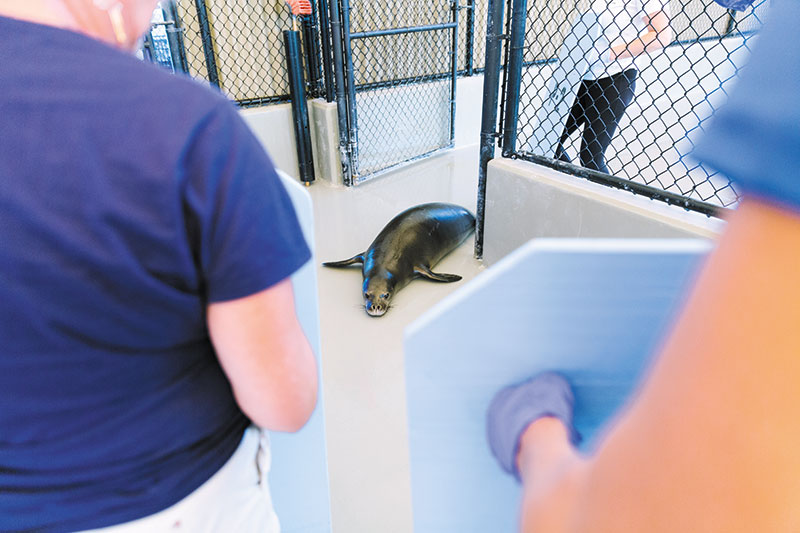
Animal care volunteers carefully use herding boards to move Hawaiian monk seal patient Maiapilo into a rehabilitation pen. ELENA GRAHAM PHOTO, THE MARINE MAMMAL CENTER, NOAA PERMIT #18786
The volunteer force consists of citizens from all walks of life — lawyers, retirees, recent grads, dancers, military members, the dive community, EPA scientists and lifeguards, to name a few. They don’t need a science background, just a passion for helping endangered seals. Volunteer duties range from helping to mark off seal haul-out areas with signs and protective barriers to keep the public and the animal safe, treating and filtering the water in the pools once a week, as well as feeding.
The center also organizes community outreach to schools, youth programs, and high school and college students to help publicize the center’s mission and nurture future stewards of the environment. A great example is the recently developed marine science program, Nā Kōkua o ke Kai, which is specifically tailored to meet the unique needs of students in grades 6-8 and their teachers on Hawai‘i Island.
“Yes, we all get attached to them while they’re here, and releasing them is bittersweet,” says McGinnis as she monitors the four patients in their pools via remote cameras. “But we also know that what’s best for them is to improve their health and get them released back into the wild so they can thrive. It’s so rewarding to see them improve, know that all our hard work paid off and that we got to make a difference.”
For more information on The Marine Mammal Center’s operations in Kailua-Kona, visit marinemammalcenter.org.
Hawaiian Monk Seals: How to Make a Difference
• It’s natural for monk seals to come ashore to rest, molt, give birth and care for pups. Please give them space.
• Monk seals are a protected species and it is important to allow them to rest undisturbed while they are hauled out.
• In the ocean, monk seals may exhibit inquisitive behavior. Avoid approaching or “playing” with them.
• Allow seals to remain wild and hunt for food on their own. Feeding them is illegal.
• When in the presence of a monk seal, please keep your dog on a leash at all times to prevent disease transmission and injury to both animals.
• Call 987-0765 on Hawai‘i Island or 800-256-9850 statewide to report a monk seal sighting.
Information courtesy NOAA Fisheries, Pacific Islands Region
